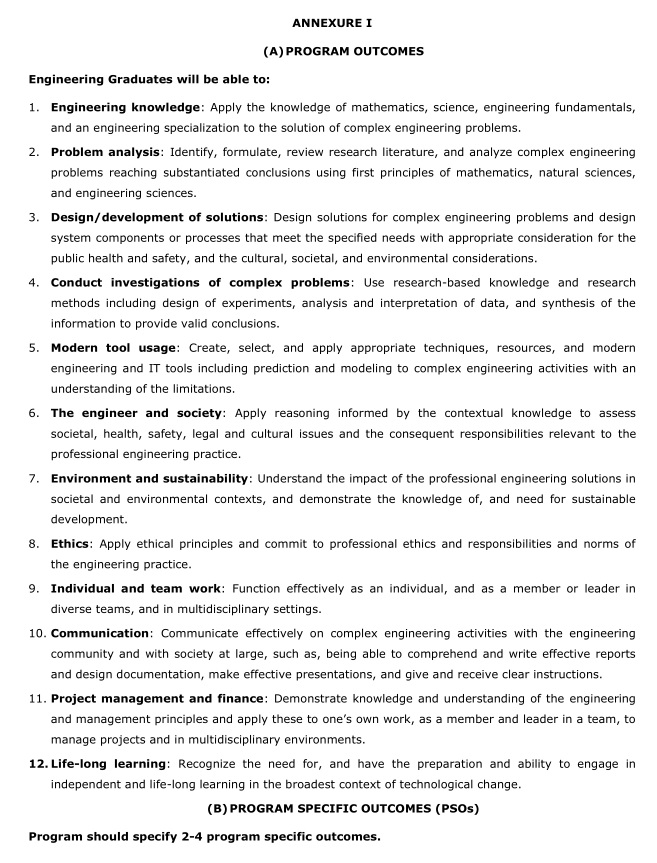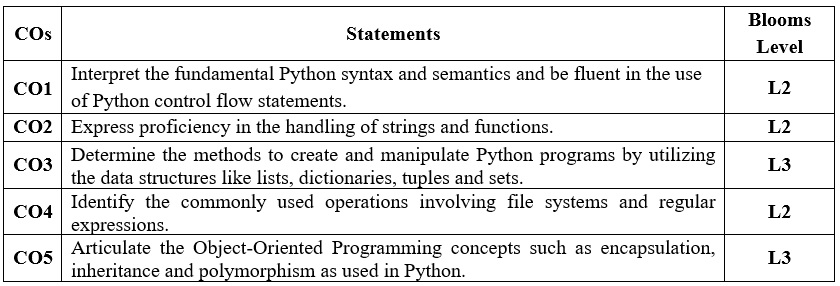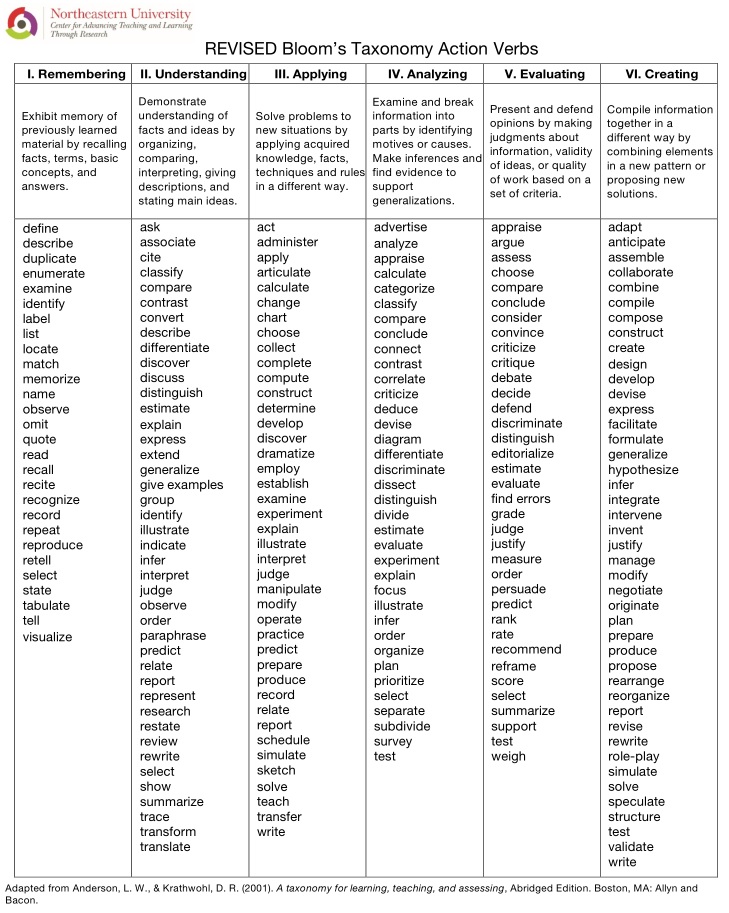Recently, me along with my colleagues Prof. Veena A. (Dept. of CSE, Dr.AIT) and Prof. Pushpaveni H (Dept. of CSE, Dr.AIT), were assigned with the task to come up with a process for writing the Course Outcomes (COs) for a course and the mapping of the Course Outcomes with Program Outcomes (POs) for Course Articulation Matrix.
Along with listing the process of writing the COs and mapping of CO-PO course articulation matrix, this article starts by giving the background information regarding NBA, Vision and Mission statements, the need for OBE and Rubrics.
National Board of Accreditation
National Board of Accreditation (NBA) is responsible for the accreditation of higher education institutions in India. NBA is also a full member of the Washington Accord. NBA accredits programmes and not the institutions.
If an institution is planning to apply for NBA accreditation for a department, then in Criterion 3.1 of Self Assessment Report (SAR) of NBA document, you are explicitly asked to mention the CO - PO mapping for a minimum of 8 core courses.
So before applying for NBA accreditation, the concerned department should make sure that their COs are well defined and serves the purpose of Outcome Based Education (OBE). Institutions adopting OBE try to bring changes to the curriculum by dynamically adopting to the requirements of the different stakeholders like Students, Parents, Industry Personnel and Recruiters.
Higher Education Institutions in India are classified into two categories by NBA
Tier - 1 Institutions consists of all IITs, NITs, Central Universities, State Universities and Autonomous Institutions. Tier - 1 institutions can also claim the benefits as per the Washington Accord.
Tier - 2 Institutions consists of affiliated colleges of Universities.
You should define Institute Vision and Mission and Department Vision and Mission to comply with the tradition, culture and ethos of your institution.
Institution Vision:
Vision is a picture of the future you seek to create, described in the present tense, as if it were happening now. It shows where we want to go, and what we will be like when we get there.
Institution Mission:
Mission statement defines what an institution is, why the institution exists, its reason for being. It defines what are we here to do together.
Department Vision
The vision and mission of the department should be correlated with the mission and vision of the institution.
Department Mission
A mission statement might include a brief history and philosophy of the academic programme, the type of students to be served, the academic environment and primary focus of the curriculum, faculty roles, outreach to the community and the role of research.
A senior professor who has undergone NBA training should be designated as NBA coordinator for a programme.
What is Outcome Based Education (OBE)?
Institutions adopting OBE try to bring changes to the curriculum by dynamically adapting to the requirements of the different stakeholders like Students, Parents, Industry Personnel and Recruiters. OBE is all about feedback and outcomes.
Four levels of outcomes from OBE are:
- Program Outcomes (POs)
-
Course Outcomes (COs)
-
Program Educational Objectives (PEOs)
-
Program Specific Outcomes (PSOs)
Why OBE?
- International recognition and global employment opportunities.
- More employable and innovative graduates with professional and soft skills, social responsibility and ethics.
- Better visibility and reputation of the technical institution among stakeholders.
- Improving the commitment and involvement of all the stakeholders.
- Enabling graduates to excel in their profession and accomplish greater heights in their careers.
- Preparing graduates for the leadership positions and challenging them and making them aware of the opportunities in the technology development.
Benefits of OBE for Faculty Members
Faculty members are referred to as Change of Agents in OBE.
- Teaching will become a far more creative and innovative career.
- Faculty members will no longer feel the pressure of having to be the “source of all knowledge”.
- Faculty members shape the thinking and vision of students towards a course.
Program Outcomes (POs)
POs describe what students should know and be able to do at the end of the programme. POs are to be in line with the graduate attributes as specified in the Washington Accord. POs are to be specific, measurable and achievable.
NBA has defined 12 POs (see below) and you need not define those POs by yourself and it is common for all the institutions in India.

In the syllabus book given to students, there should be clear mention of course objectives and course outcomes along with CO-PO course articulation matrix for all the courses.
Course Outcomes (COs)
Course outcomes are the statements of what a student should know, understand and/or be able to demonstrate after completion of a course. While writing COs for a course, please remember the following points.
- The COs must state the major skills, knowledge, attitude or ability that students will acquire.
- COs should be expressed in terms of measurable and/or observable behaviors.
- COs should be agreed upon by the faculty in a program and should drive program outcomes.
- All the courses in the department should have a uniform number of COs.
- The COs should be written by Professors who have demonstrated considerable expertise in that course and then identify the textbook for the course.
- The syllabus book should have course articulation matrix for CO-PO mapping of all the courses.
- There should be a minimum of 6 COs according to the NBA.
- Course outcomes should begin with an action verb from Bloom’s taxonomy.
Here is a sample list of COs written for Python Programming course.

Program Educational Objectives (PEOs)
Program Educational Objectives (PEOs) should be defined by the Department HEAD in consultation with the faculty members. PEOs are an promise by the Department HEAD to the aspiring students about what they will achieve once they join the programme. PEO assessment is not compulsory in India as it is quite difficult to measure in Indian context. NBA Assessors usually do not ask for PEO assessment. PEOs are about professional and career accomplishment after 4 to 5 years of graduation. PEOs can be written from different perspectives like Career, Technical Competency and Behavior. While writing the PEOs do not use the technical terms as it will be read by prospective students who wants to join the programme. Three to five PEOs are recommended.
Program Specific Outcomes (PSOs)
Program Specific Outcomes (PSOs) are statements that describe what the graduates of a specific engineering program should be able to do. A list of PSOs written for the department of Computer Science and Engineering at Dr.Ambedkar Institute of Technology, Bengaluru is given below.
PSO1: To apply the knowledge obtained through rigorous analysis of algorithms for advancing the broad area of computer science and engineering.
PSO2: To bring forth the creative zeal and work efficiently in designing the solution to various software and hardware problems by using state of the art tools.
PSO3: To assimilate professional ethics, managerial skills and to officiate effectively as a leader in a team to manage diverse projects.
Blooms Taxonomy
Bloom’s taxonomy is considered as the global language for education. Bloom’s Taxonomy is frequently used by teachers in writing the course outcomes as it provides a ready made structure and list of action verbs. Here is the revised Bloom’s document with action verbs, which we frequently refer to while writing COs for our courses.

CO-PO Course Articulation Matrix Mapping
Course Articulation Matrix shows the educational relationship (Level of Learning achieved) between Course Outcomes and Program Outcomes for a Course. This matrix strongly indicates whether the students are able to achieve the course learning objectives. The matrix can be used for any course and is a good way to evaluate a course syllabus.
The below table (Table 1) gives information about the action verbs used in the POs and the nature of POs, stating whether the POs are technical or non-technical. You need to understand the intention of each POs and the Bloom’s level to which each of these action verbs in the POs correlates to. Once you have understood the POs then you can write the COs for a course and see to what extent each of those COs correlate with the POs.
Table 1: Process for mapping the values for CO-PO Matrix
| Type | POs | Action Verb(s) in POs | Bloom’s level(s) for POs | Bloom’s level(s) for COs |
|---|---|---|---|---|
| Technical | PO1 | Apply | L3 | Bloom’s L1 to L4 -> Theory Courses Blooms’s L1 to L5 -> Laboratory Courses Bloom’s L1 to L6 -> Mini Project and Main Project |
| PO2 | Identify | L2 | ||
| Formulate | L6 | |||
| Review | L2 | |||
| PO3 | Design | L6 | ||
| Develop | L3, L6 | |||
| PO4 | Analyze | L4 | ||
| Interpret | L2, L3 | |||
| Design | L6 | |||
| PO5 | Create | L6 | ||
| Select | L1, L2, L6 | |||
| Apply | L3 | |||
| Non-Technical | PO6 | THUMB RULE If Bloom’s L1 Action Verbs of a CO -> Correlates with any of PO6 to PO12 -> then assign 1 If Bloom’s L2 to L3 Action Verbs of a CO -> Correlates with any of PO6 to PO12 -> then assign 2 If Bloom’s L4 to L6 Action Verbs of a CO -> Correlates with any of PO6 to PO12 -> then assign 3 |
||
| PO7 | ||||
| PO8 | ||||
| PO9 | ||||
| PO10 | ||||
| PO11 | ||||
| PO12 | ||||
NOTE:
- The first five POs are purely of technical in nature, while the other POs are non-technical.
- For the theory courses, while writing the COs, you need to restrict yourself between Blooms Level 1 to Level 4. Again, if it is a programming course, restrict yourself between Blooms Level 1 to Level 3 but for the other courses, you can go up to Blooms Level 4.
- For the laboratory courses, while composing COs, you need to restrict yourself between Blooms Level 1 to Level 5.
- Only for Mini-project and Main project, you may extend up to Blooms Level 6 while composing COs.
- For a given course, the course in-charge has to involve all the other Professors who teach that course and ask them to come up with the CO-PO mapping. The course in-charge has to take the average value of all of these CO-PO mappings and finalize the values or the course in-charge can go with what the majority of the faculty members prefer for. Ensure that none of the Professors who are handling the particular course discuss with each other while marking the CO-PO values.
- If you want to match your COs with non-technical POs, then correlate the action verbs used in the course COs with the thumb rule given in the table and map the values. (Applies only for mapping COs to non-technical POs).
Tips for Assigning the values while mapping COs to POs.
-
Select action verbs for a CO from different Bloom’s levels based on the importance of the particular CO for the given course.
-
Stick on to single action verbs while composing COs but you may go for multiple action verbs if the need arises.
-
You need to justify for marking of the values in CO-PO articulation matrix. Use a combination of words found in the COs, POs and your course syllabus for writing the justification. Restrict yourself to one or two lines.
-
Values to CO-PO (technical POs in particular) matrix can be assigned by
a. Judging the importance of the particular CO in relation to the POs. If the CO matches strongly with a particular PO criterion then assign 3, if it matches moderately then assign 2 or if the match is low then assign 1 else mark with “ - ” symbol.
b. If an action verb used in a CO is repeated at multiple Bloom’s levels, then you need to judge which Bloom’s level is the best fit for that action verb.
A sample CO-PO Course Articulation matrix mapping for the Python Programming course.

You can also find a list of COs and CO-PO course articulation matrix mapping for the Python programming course here
What is Rubrics?
We strongly recommend all the institutions to adopt Rubrics. Rubrics is a scoring guide that is used to evaluate the quality of students’ constructed responses. Usually Rubrics is designed for laboratory, projects and seminar courses. In Indian universities, there is a trend of allocating the marks based on face value of the students and there is no appropriate breakup of the marks for the course. Usually, a faculty sees a student and allocates marks based on his opinion about the student. This tends to have negative effect on the student as there is no transparency in allocation of marks. We can overcome these kind of problems by adopting and designing Rubrics. More about Rubrics can be found here.
Advantages:
1) Sets focus on the stated objectives.
2) Sets a common framework and language for assessment.
3) Grading consistency among the students and faculty members.
4) Enables peer review among the students themselves.
5) Clear Instructions to students on the intended outcomes.
6) Diagnosing specific Strengths and Weaknesses among students.
Faculty members should always distribute the Rubrics designed for a course to the students so that they do understand how they are accessed.
Few Clarifications
Course: A semester consists of 5 to 6 theory courses and 2 to 3 laboratory courses. A course is a unit of teaching. We Indians tend to use the term Subject instead of Course. Please avoid the use of the term “Subject”. Use the term Course instead of subject. The term Programme is different from the Department.
Programme: An programme is a cohesive arrangement of courses, co-curricular and extra-curricular activities to accomplish predetermined objectives leading to the award of individual degrees like B.E., B.Tech, M.Tech and Ph.D. from a department. A department can offer different programmes.
Degree: Academic award conferred upon a student upon successful completion of a programme. For example, B.E. Degree Programme, B.Tech Degree Programme, M.E. Degree Programme and M.Tech Degree Programme.
Output and Outcome: These two terms can be explained easily with an example. If you produce Ph.D students then it is Output. If the Ph.D students are able to get funds and publish papers then it is Outcome.
Take the above information with a pinch of salt and do not consider it as gospel.
Hope it helps someone out there!!!
 Software Artist
Software Artist
Comments
comments powered by Disqus